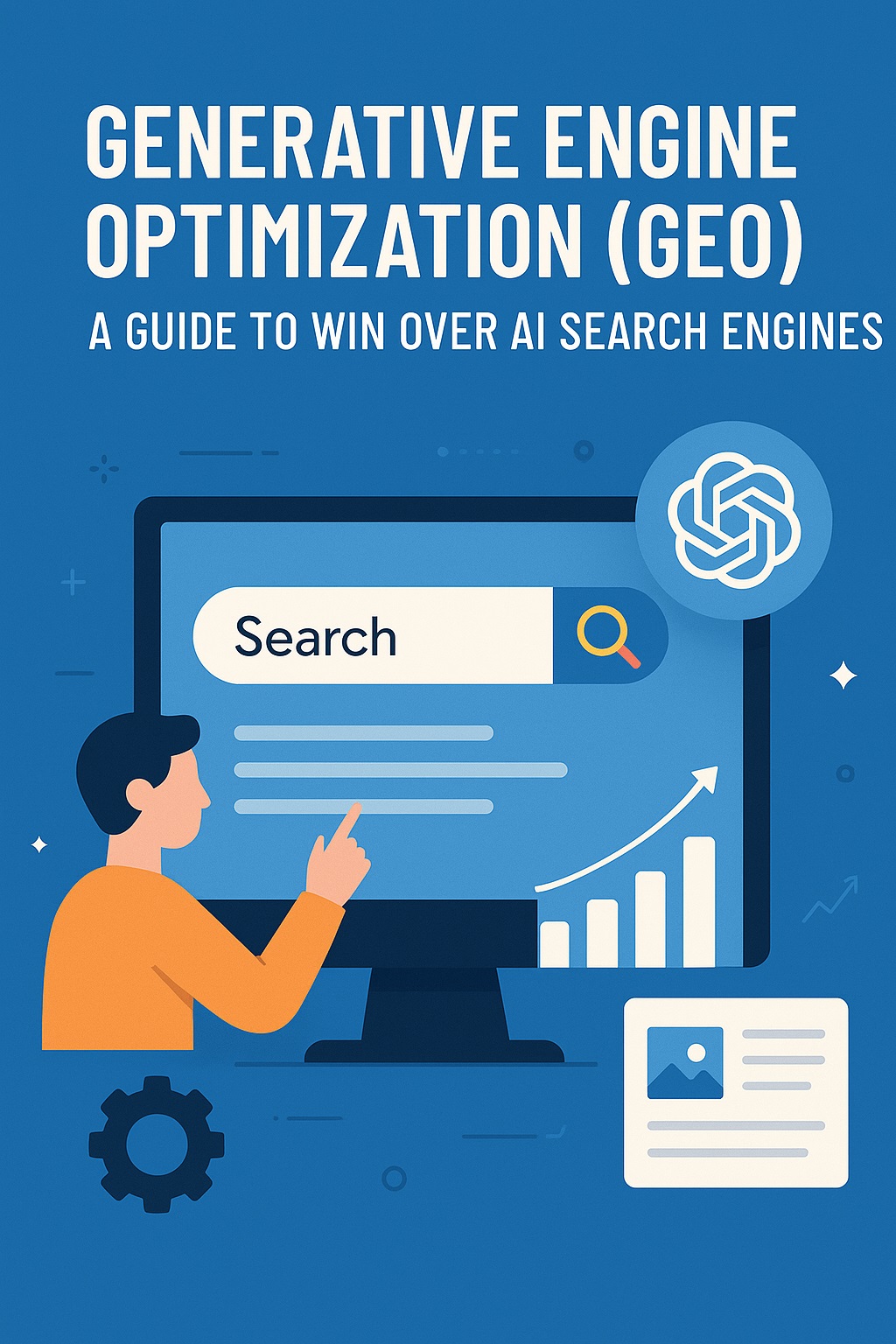Digital marketing is changing from the traditional search engine to generative artificial intelligence such as ChatGPT, the AI Overviews (SGE) by Google, Gemini, Claude, and Perplexity. To counteract this, the brands are implementing Generative Engine Optimization (GEO) as the strategic approach of optimizing the content that is referenced, included, or canned in the answers that are generated by the AI.
The industry research suggests that the selection of GEO can enhance the visibility of the AI‑generated responses by up to 40 per cent. By the middle of 2025, GEO is not optional anymore; it is critical to reach, remain relevant, and have an effective brand.
1. What is GEO (Generative Engine Optimization)?

Definition: GEO refers to the process of optimising your content and internet presence in such a way that the AI-driven search engines are likely to choose, mention, or incorporate your content in the answers they give, other than merely giving a link as is done in the case of conventional SEO applications
GEO was first termed in late 2023 and codified through the scientific study as an offset against the link-based ranking system in favor of AI-first visibility.
2. Why GEO Matters Today
The search volume of the Internet is shifting towards AI-driven tools. Google is also promoting the search results with its AI-driven answers that make the information more accessible.
2.1 The Rise of AI-Driven Search
- By February 2025, ChatGPT had more than 400 million active users per week.
- Overviews of Google AI now pop up in at least 13 percent of all SERPs and more than half of all the keywords that are being monitored.
- There is some evidence, up to 40 percent of search queries are answered not based on a click, it is the so-called zero-click phenomenon.
2.2 Threat to Traditional SEO Traffic
Ranking and CTR are some of the traditional metrics of SEO, which are experiencing diminishing returns on SEO since users are reading through AI summaries rather than clicking. Companies such as Mailchimp or Back Market note decreased traffic patterns and are moving their marketing efforts to serve AI-crawlers and talk-based content.
2.3 Emergence of New Analytics Tools
At Athena, Profound, and Scrunch AI, new startups are pouring funds into such AI‑generated search visibility tracking and optimisation tools
3. GEO vs. SEO vs. AEO: A Comparative Framework
| Optimization Approach | Primary Goal | Typical Content Style | Key Signals & Metrics |
| Traditional SEO | Rank high in search engine results pages (SERPs) | Keyword-rich, link optimized, meta tags | Keyword rankings, backlinks, CTR, bounce rate |
| Answer Engine Optimization (AEO) / AIO | Be selected for featured snippets or voice answers | Structured Q&A, schema, concise answers | Snippet inclusion, voice response metrics |
| Generative Engine Optimization (GEO) | Be cited or sourced within AI-generated responses | Contextual, narrative, authority-based | Citation frequency in ChatGPT/AI Overviews, brand mentions |
Table 1: Comparative Analysis
GEO requires a wider scope of power signals, machine-readable organization, and a wide web appearance, not just using powerful keywords or links.
4. How GEO Works: Key Strategies
There are some common strategies that one can use to get a high rank in the search engine and get a reference in the AI-generated responses.
4.1 Optimize the Foundations
- GEO is built upon solid technical SEO: pages that load quickly, mobile mobile-friendly structure, and schema markup to assist generative models to interpret documents with ease.
- Keep a good EEAT: Experience, Expertise, Authoritativeness, and Trustworthiness is the key to AI trustworthiness.
4.2 Content Structure & Format
- Provide headings, lists, question-answer form, and bullet points to facilitate summarising.
- Write in a language that is conversational yet to the point, just like what human beings would phrase in answering queries.
- Mention authoritative sources and information, which may enhance the chance of being cited.
4.3 Distribution & Brand Signals
- Write on a variety of trusted platforms to increase brand mentions, even without backlinks, no matter the field, it strengthens the credibility of the reference model of AI.
- The other way is to get brand mentions across the web, through PR, industry comments, or third-party quoting.
4.4 Tracking & Testing
- Manual Testing: Put a row of questions to ChatGPT, Claude, Gemini, Perplexity, and Google AI Mode, and note what is referenced over time.
- Analytics tools: Services such as Semrush Enterprise AIO, Profound, or Athena make it possible to track the brand presence and brand mentioning within AI-powered systems
5. Seven-Step GEO Implementation Plan
These steps are listed in the industry-standard action plan by Backlinko:
- Basic SEo of Nails: technical structure, speed, schema.
- Apply manual query testing on the AI engines.
- Use AI tracking solutions to track any mentions of the brand.
- Create quality and authoritative content with the purpose of being directed to the AI Q&A contexts.
- Write meant by structure with headings, list, schema.
- Establish brand power through distributed mentions and citations.
- Repeat on performance results and changing behavior of AI.
6. Pitfalls to Avoid
- Treating GEO like old‑school SEO: GEO is not all about keywords and backlinks good reputation, organization, and integration into AI summaries.
- Creation of shallow or artificial content: AI systems are neither provoked by shallow content nor by spam; they like deep and competent coverage, sincere human voice is important.
- Lack of technical accessibility: Bots prefer machine-readable pages; an error or delay spells their rejection.
7. The Broader Context: Startup Ecosystem & Trends
The newer market area being raced to cover by startups is helping brands to be seen better by AI searches.
- Athena, Profound, Scrunch AI. All of these startups are getting millions of dollars to provide software to monitor how AI models acquire and display their data on brands.
- The importance of their analytics expresses the dissimilarities between the AI platforms with regard to sourcing, tone, and citation behavior.
In the meantime, trust issues are increasing: it has been proven through some studies that AI models can elevate popular yet less reliable content, and in such a way, the voices of real humans and authoritative materials become essential.
8. Looking Ahead: GEO and the Future of Search
Generative search is not another temporary stage; users are already moving towards AI-based tools to find information. As early as 2026, organic traffic will drop by 20 to 40 percent in brands that are relying only on traditional SEO.
To prosper:
- Combine GEO with general AI Search Optimization (AIO) and Answer Engine Optimization (AEO) techniques.
- Get ready: text, voice, images, and zero-click interface: AI platforms are becoming increasingly integrated, offering predictive, multimodal, and personalized experiences for the future.
- Continue investing in technical proficiency, subject expertise, and distributed reference.
Final Words
Generative Engine Optimization is not a fad but a fundamental strategic shift that brands need to consider to remain in the eyes of the audience on AI-enabled search. GEO is not a substitute for SEO; it complements it with structure, authority, and conversational fluency, to get an AI system to pay attention.
However, integration of technical frameworks, professional information, organized listings, and brand recognition allows you to not only be indexed in AI-generated text but also be embedded within it, not being hidden in back-street links.
Take the GEO steps plan of action seriously. Monitor with tools and by hand. Performance-based iterate. Above all, communicate as the machines: decipherable, believable, chatty, and trusted. This is how your content can succeed in the new period of AI discovery.

 +91 9836 720 921
+91 9836 720 921 +91 9836 720 921
+91 9836 720 921 saha@zenithsolz.com
saha@zenithsolz.com soumya.seo@outlook.com
soumya.seo@outlook.com